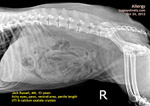Blood test - monocytes higher than normal at 11.2%. Other values are normal.
Calcium and uric acid within normal range. Liver, kidney, joints normal.
Dental scaling under general anaesthesia was done by Dr Daniel and the dog went home.
The "occasional" presence of calcium oxalate does not mean there
are no urinary stones inside the bladder. Absence of crystals does not mean there
are no urinary stones. Much depends on the clinical signs of
blood in the urine. The dog was furiously licking his penile
length till the area was red and hairless. This was unusual.
There could be difficulty in urination but nobody knows as the
caregiver owner was studying in the US. X-rays did not show the
radio-dense calcium oxalate stones in big sizes.
It is good preventive
medicine to do a health screening on old dogs. The blood and urine tests
were done in this
case. Calcium oxalate urinary crystals were found. I advised
prevention of more calcium oxalate urinary
stones by feeding a specific diet.
FEEDING OF U/D CANINE NON-STRUVITE URINARY TRACT HEALTH
Indications: Urolithiasis due to calcium oxalate, urate and
cystine stones; end-stage kidney disease.
Decreases purine intake and uric acid
excretion, which lowers the risk of forming urate crystals and
uroliths
Monitoring Urine SG, urinary pH and BUN will let the vet know
the food's effectiveness and owner compliance. Dogs fed on this
diet commonly show unusual lab values like USG <1 .020.
Long
term use: Check for protein depletion as U/D is a low protein
diet to decrease urea production, but the protein level is
suitable for maintenance of the adult dog. Advise a fasting
serum chemistry profile and ECG every 6 months.



 Toa
Payoh Vets
Toa
Payoh Vets